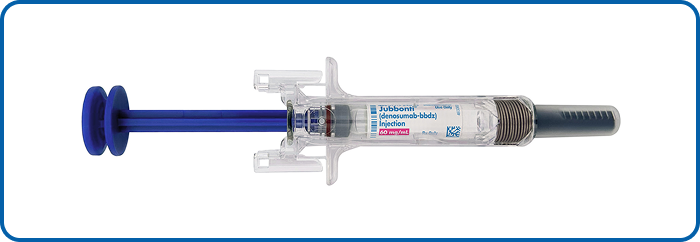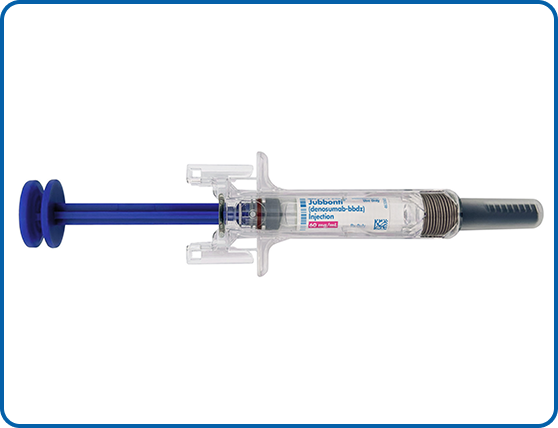
IMPORTANT SAFETY INFORMATION AND INDICATIONS
INDICATIONS
Jubbonti (denosumab-bbdz) is indicated:
- For the treatment of postmenopausal women with osteoporosis at high risk for fracture, defined as a history of osteoporotic fracture, or multiple risk factors for fracture; or patients who have failed or are intolerant to other available osteoporosis therapy. In postmenopausal women with osteoporosis, denosumab reduces the incidence of vertebral, nonvertebral, and hip fractures.
- For treatment to increase bone mass in men with osteoporosis at high risk for fracture, defined as a history of osteoporotic fracture, or multiple risk factors for fracture; or patients who have failed or are intolerant to other available osteoporosis therapy.
- For the treatment of glucocorticoid-induced osteoporosis in men and women at high risk of fracture who are either initiating or continuing systemic glucocorticoids in a daily dosage equivalent to 7.5 mg or greater of prednisone and expected to remain on glucocorticoids for at least 6 months. High risk of fracture is defined as a history of osteoporotic fracture, multiple risk factors for fracture, or patients who have failed or are intolerant to other available osteoporosis therapy.
- As a treatment to increase bone mass in men at high risk for fracture receiving androgen deprivation therapy (ADT) for nonmetastatic prostate cancer. In these patients denosumab also reduced the incidence of vertebral fractures.
- As a treatment to increase bone mass in women at high risk for fracture receiving adjuvant aromatase inhibitor (AI) therapy for breast cancer.
IMPORTANT SAFETY INFORMATION
WARNING: SEVERE HYPOCALCEMIA IN PATIENTS WITH ADVANCED KIDNEY DISEASE
- Patients with advanced chronic kidney disease (eGFR < 30 mL/min/1.73 m2), including dialysis-dependent patients, are at greater risk of severe hypocalcemia following denosumab products administration. Severe hypocalcemia resulting in hospitalization, life-threatening events and fatal cases have been reported.
- The presence of chronic kidney disease-mineral bone disorder (CKD-MBD) markedly increases the risk of hypocalcemia in these patients.
- Prior to initiating Jubbonti in patients with advanced chronic kidney disease, evaluate for the presence of CKD-MBD. Treatment with Jubbonti in these patients should be supervised by a healthcare provider with expertise in the diagnosis and management of CKD-MBD.
CONTRAINDICATIONS
- Patients with hypocalcemia: pre-existing hypocalcemia must be corrected prior to initiating therapy.
- Pregnant women: denosumab products may cause fetal harm when administered to a pregnant woman. In women of reproductive potential, pregnancy testing should be performed prior to initiating treatment.
- Patients with hypersensitivity to denosumab products: Jubbonti is contraindicated in patients with a history of systemic hypersensitivity to any component of the product. Reactions have included anaphylaxis, facial swelling, and urticaria.
WARNINGS AND PRECAUTIONS
Severe Hypocalcemia and Mineral Metabolism Changes
- Denosumab products can cause severe hypocalcemia and fatal cases have been reported. Pre-existing hypocalcemia must be corrected prior to initiating therapy with Jubbonti. Adequately supplement all patients with calcium and vitamin D.
- In patients without advanced chronic kidney disease who are predisposed to hypocalcemia and disturbances of mineral metabolism, assess serum calcium and mineral levels (phosphorus and magnesium) 10 to 14 days after Jubbonti injection. In some postmarketing cases, hypocalcemia persisted for weeks or months and required frequent monitoring and intravenous and/or oral calcium replacement, with or without vitamin D.
- Patients with Advanced Chronic Kidney Disease
- Patients with advanced chronic kidney disease [i.e., eGFR < 30 mL/min/1.73 m2] including dialysis-dependent patients are at greater risk for severe hypocalcemia following denosumab products administration. Severe hypocalcemia resulting in hospitalization, life-threatening events and fatal cases have been reported. The presence of underlying chronic kidney disease-mineral bone disorder (CKD-MBD, renal osteodystrophy) markedly increases the risk of hypocalcemia. Concomitant use of calcimimetic drugs may also worsen hypocalcemia risk.
- To minimize the risk of hypocalcemia in patients with advanced chronic kidney disease, evaluate for the presence of chronic kidney disease mineral and bone disorder with intact parathyroid hormone (iPTH), serum calcium, 25(OH) vitamin D, and 1,25 (OH)2 vitamin D prior to decisions regarding Jubbonti treatment. Consider also assessing bone turnover status (serum markers of bone turnover or bone biopsy) to evaluate the underlying bone disease that may be present. Monitor serum calcium weekly for the first month after Jubbonti administration and monthly thereafter. Instruct all patients with advanced chronic kidney disease, including those who are dialysis-dependent, about the symptoms of hypocalcemia and the importance of maintaining serum calcium levels with adequate calcium and activated vitamin D supplementation. Treatment with Jubbonti in these patients should be supervised by a healthcare provider who is experienced in diagnosis and management of CKD-MBD.
Drug Products with Same Active Ingredient
- Patients receiving Jubbonti should not receive other denosumab products concomitantly.
Hypersensitivity
- Clinically significant hypersensitivity including anaphylaxis has been reported with denosumab products. Symptoms have included hypotension, dyspnea, throat tightness, facial and upper airway edema, pruritus, and urticaria. If an anaphylactic or other clinically significant allergic reaction occurs, initiate appropriate therapy and discontinue further use of Jubbonti.
Osteonecrosis of the Jaw (ONJ)
- ONJ, which can occur spontaneously, is generally associated with tooth extraction and/or local infection with delayed healing and has been reported in patients receiving denosumab products. An oral exam should be performed by the prescriber prior to initiation of Jubbonti. A dental examination with appropriate preventive dentistry is recommended prior to treatment in patients with risk factors for ONJ such as invasive dental procedures, diagnosis of cancer, concomitant therapies (e.g., chemotherapy, corticosteroids, angiogenesis inhibitors), poor oral hygiene, and comorbid disorders. Good oral hygiene practices should be maintained during treatment with Jubbonti. Concomitant administration of drugs associated with ONJ may increase the risk of developing ONJ. The risk of ONJ may increase with duration of exposure to denosumab products.
- For patients requiring invasive dental procedures, clinical judgment should guide the management plan of each patient. Patients who are suspected of having or who develop ONJ should receive care by a dentist or an oral surgeon. Extensive dental surgery to treat ONJ may exacerbate the condition. Discontinuation of Jubbonti should be considered based on individual benefit-risk assessment.
Atypical Subtrochanteric and Diaphyseal Femoral Fractures
- Atypical low energy or low trauma fractures of the shaft have been reported in patients receiving denosumab products. Causality has not been established as these fractures also occur in osteoporotic patients who have not been treated with antiresorptive agents. During Jubbonti treatment, patients should be advised to report new or unusual thigh, hip, or groin pain. Any patient who presents with thigh or groin pain should be evaluated to rule out an incomplete femur fracture. Patients presenting with an atypical femur fracture should also be assessed for symptoms and signs of fracture in the contralateral limb. Interruption of Jubbonti therapy should be considered, pending a risk-benefit assessment, on an individual basis.
Multiple Vertebral Fractures (MVF) Following Treatment Discontinuation
- Following discontinuation of denosumab treatment, fracture risk increases, including the risk of multiple vertebral fractures. New vertebral fractures occurred as early as 7 months (on average 19 months) after the last dose of denosumab. Prior vertebral fracture was a predictor of multiple vertebral fractures after denosumab discontinuation. Evaluate an individual’s benefit-risk before initiating treatment with Jubbonti. If Jubbonti treatment is discontinued, patients should be transitioned to an alternative antiresorptive therapy.
Serious Infections
- In a clinical trial of over 7800 women with postmenopausal osteoporosis, serious infections leading to hospitalization were reported more frequently in the denosumab group than in the placebo group. Serious skin infections, as well as infections of the abdomen, urinary tract, and ear, were more frequent in patients treated with denosumab.
- Endocarditis was also reported more frequently in denosumab-treated patients. The incidence of opportunistic infections was similar between placebo and denosumab groups, and the overall incidence of infections was similar between the treatment groups. Advise patients to seek prompt medical attention if they develop signs or symptoms of severe infection, including cellulitis.
- Patients on concomitant immunosuppressant agents or with impaired immune systems may be at increased risk for serious infections. In patients who develop serious infections while on Jubbonti, prescribers should assess the need for continued therapy with Jubbonti.
Dermatologic Adverse Reactions
- In a clinical trial of over 7800 women with postmenopausal osteoporosis, epidermal and dermal adverse events such as dermatitis, eczema, and rashes occurred at a significantly higher rate in the denosumab group compared to the placebo group. Most of these events were not specific to the injection site. Consider discontinuing Jubbonti if severe symptoms develop.
Musculoskeletal Pain
- Severe and occasionally incapacitating bone, joint, and/or muscle pain has been reported in patients taking denosumab products. Consider discontinuing use if severe symptoms develop.
Suppression of Bone Turnover
- In clinical trials in women with postmenopausal osteoporosis, treatment with denosumab resulted in significant suppression of bone remodeling as evidenced by markers of bone turnover and bone histomorphometry. The significance of these findings and the effect of long-term treatment with denosumab products are unknown. Monitor patients for consequences, including ONJ, atypical fractures, and delayed fracture healing.
Hypercalcemia in Pediatric Patients with Osteogenesis Imperfecta
- Jubbonti is not approved for use in pediatric patients. Hypercalcemia has been reported in pediatric patients with osteogenesis imperfecta treated with denosumab products. Some cases required hospitalization.
ADVERSE REACTIONS
- The most common adverse reactions (>5% and more common than placebo) reported with denosumab products in patients with postmenopausal osteoporosis were back pain, pain in extremity, musculoskeletal pain, hypercholesterolemia, and cystitis. The most common adverse reactions (>5% and more common than placebo) reported with denosumab products in men with osteoporosis were back pain, arthralgia, and nasopharyngitis. Pancreatitis has been reported with denosumab. The most common adverse reactions leading to discontinuation of denosumab products in patients with postmenopausal osteoporosis were back pain and constipation.
- The overall incidence of new malignancies in postmenopausal women with osteoporosis was 4.3% in the placebo group and 4.8% in the denosumab group, and in men with osteoporosis, no patients in the placebo group and 3.3% in the denosumab group. A causal relationship to drug exposure has not been established.
- The most common adverse reactions (>3% and more common than active control) reported with denosumab products in patients with glucocorticoid-induced osteoporosis were back pain, hypertension, bronchitis, and headache.
- The most common adverse reactions (≥10% and more common than placebo) reported with denosumab products in patients with bone loss receiving ADT for prostate cancer or adjuvant AI therapy for breast cancer were arthralgia and back pain. Pain in extremity and musculoskeletal pain have also been reported in clinical trials. Additionally, in denosumab-treated men with nonmetastatic prostate cancer receiving ADT, a greater incidence of cataracts was observed.
Please see full Prescribing Information for Jubbonti.
All trademarks and trade names are the property of their respective owners.





